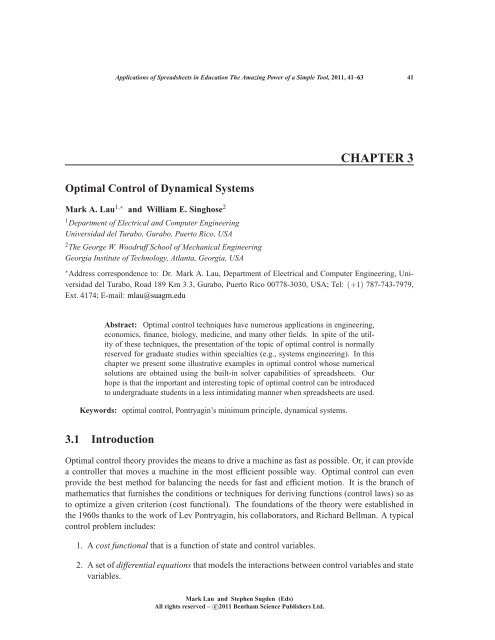chapter 3 - Bentham Science
chapter 3 - Bentham Science
chapter 3 - Bentham Science
You also want an ePaper? Increase the reach of your titles
YUMPU automatically turns print PDFs into web optimized ePapers that Google loves.
Applications of Spreadsheets in Education The Amazing Power of a Simple Tool, 2011, 41–63 41<br />
Optimal Control of Dynamical Systems<br />
Mark A. Lau 1,∗ and William E. Singhose 2<br />
1 Department of Electrical and Computer Engineering<br />
Universidad del Turabo, Gurabo, Puerto Rico, USA<br />
2 The George W. Woodruff School of Mechanical Engineering<br />
Georgia Institute of Technology, Atlanta, Georgia, USA<br />
CHAPTER 3<br />
∗ Address correspondence to: Dr. Mark A. Lau, Department of Electrical and Computer Engineering, Universidad<br />
del Turabo, Road 189 Km 3.3, Gurabo, Puerto Rico 00778-3030, USA; Tel: (+1) 787-743-7979,<br />
Ext. 4174; E-mail: mlau@suagm.edu<br />
Abstract: Optimal control techniques have numerous applications in engineering,<br />
economics, finance, biology, medicine, and many other fields. In spite of the utility<br />
of these techniques, the presentation of the topic of optimal control is normally<br />
reserved for graduate studies within specialties (e.g., systems engineering). In this<br />
<strong>chapter</strong> we present some illustrative examples in optimal control whose numerical<br />
solutions are obtained using the built-in solver capabilities of spreadsheets. Our<br />
hope is that the important and interesting topic of optimal control can be introduced<br />
to undergraduate students in a less intimidating manner when spreadsheets are used.<br />
Keywords: optimal control, Pontryagin’s minimum principle, dynamical systems.<br />
3.1 Introduction<br />
Optimal control theory provides the means to drive a machine as fast as possible. Or, it can provide<br />
a controller that moves a machine in the most efficient possible way. Optimal control can even<br />
provide the best method for balancing the needs for fast and efficient motion. It is the branch of<br />
mathematics that furnishes the conditions or techniques for deriving functions (control laws) so as<br />
to optimize a given criterion (cost functional). The foundations of the theory were established in<br />
the 1960s thanks to the work of Lev Pontryagin, his collaborators, and Richard Bellman. A typical<br />
control problem includes:<br />
1. A cost functional that is a function of state and control variables.<br />
2. A set of differential equations that models the interactions between control variables and state<br />
variables.<br />
Mark Lau and Stephen Sugden (Eds)<br />
All rights reserved – c○2011 <strong>Bentham</strong> <strong>Science</strong> Publishers Ltd.

















